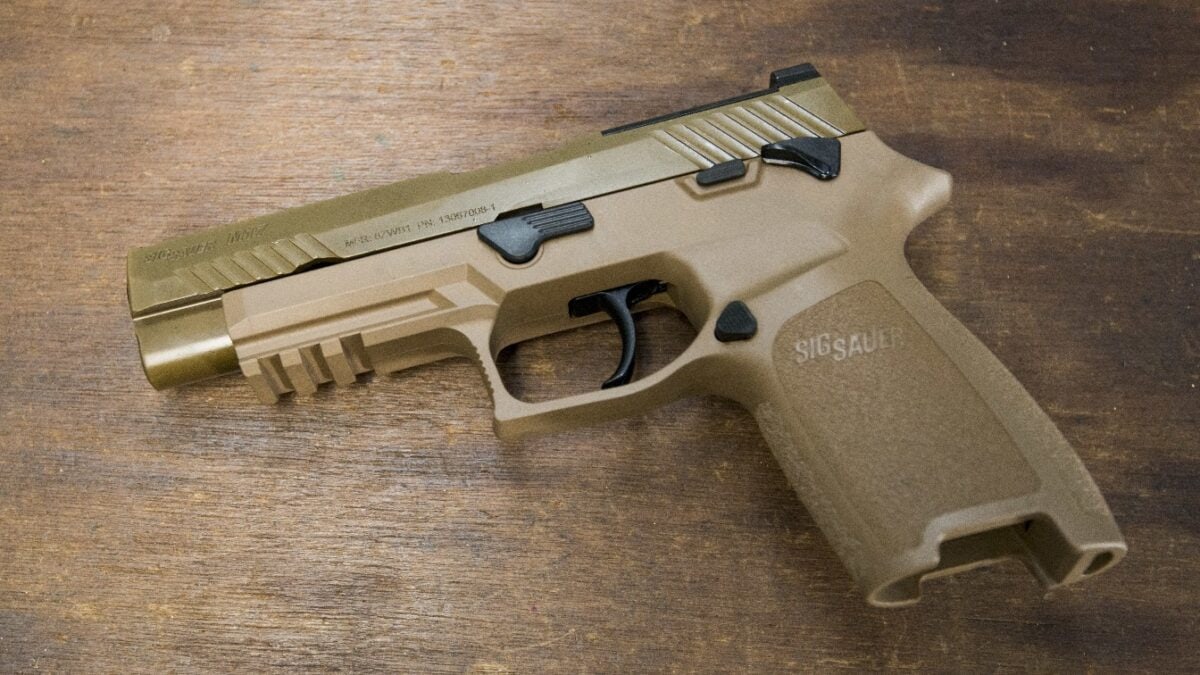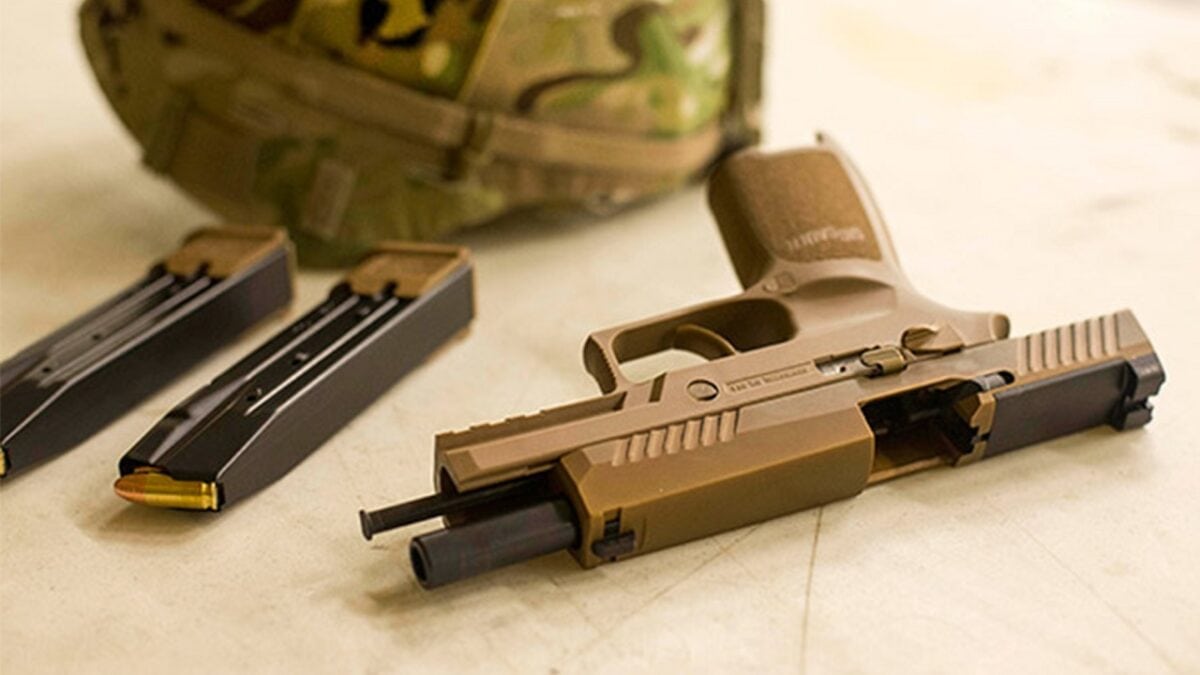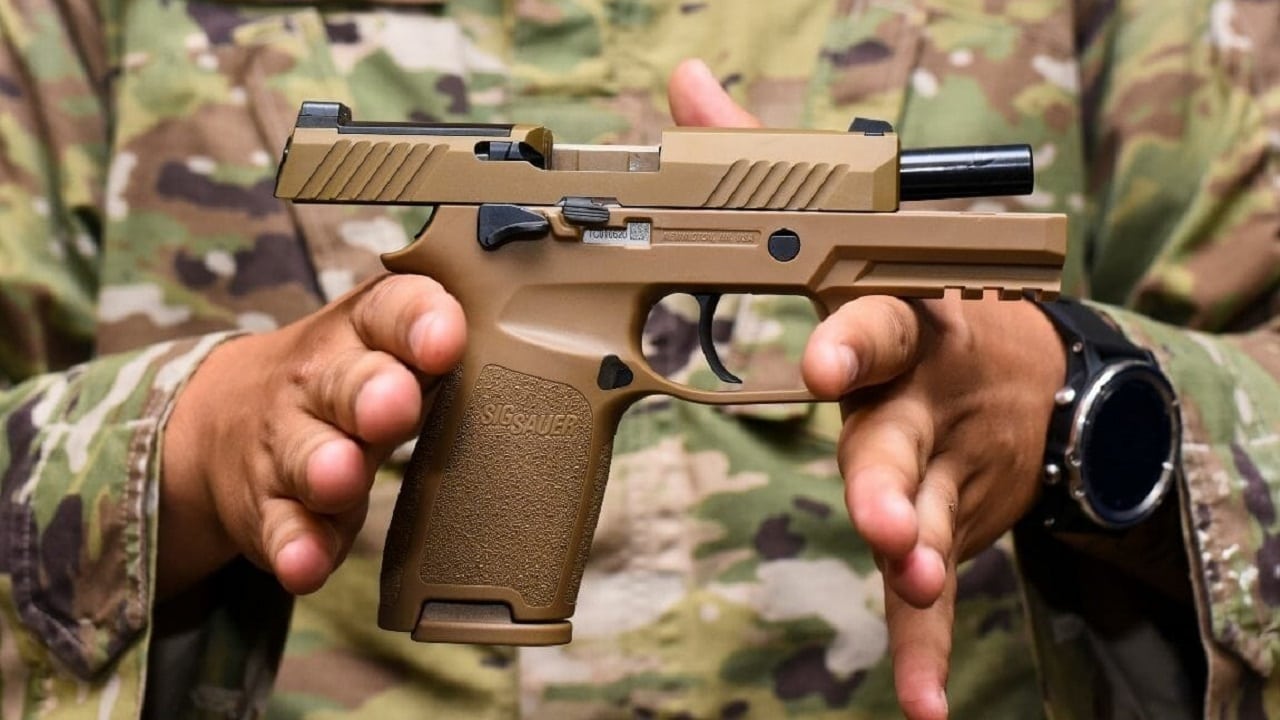Meet the Sig Sauer M17/M18 – As I noted in a recent article, the retirement of the Beretta 92FS, aka the M9, as the official standard-issue sidearm of the U.S. Armed Forces – a role it ably served from 1984 to 2017 – has been somewhat controversial. The decision has stirred up a range of emotions in the military community and among firearms enthusiasts, regardless of military or civilian status. Some say “good riddance” to what they perceived as an underpowered hunk of junk.
Plenty of others are shedding – mostly symbolic – tears of farewell to a superbly accurate and reliable pistol. Regardless of the sentiments on the M9, the fact remains that its successor, the SIG Sauer P320 AKA the M17/M18, is here to stay.
SIG Sauer: Winner, Winner, Chicken Dinner
Much to the chagrin of big-bore aficionados who think that packing an auto pistol in any caliber than .45 ACP, or maybe .40 cal/10mm if they’re a tad bit more open-minded, will leave the shooter hopelessly undergunned against anybody or anything larger than a rabid squirrel, SIG’s “new kid on the block” retains the same 9mm chambering as “Old Man Beretta,” so to speak.
Without attempting to delve into yet another endless and tiresome debate about 9mm vs. 45, the smaller round ensures continued commonality of pistol caliber with America’s allies – NATO and non-NATO alike – and allows a greater number of rounds to be the stuffed into the magazine—17 rounds in the case of the M17/M18—without excessively sacrificing ergonomics.
So then, what exactly did SIG do to win the U.S. Armed Forces contract in the face of stiff competition from the likes of Beretta USA, FN Herstal, CZ, Smith & Wesson, KRISS USA, STI, and Glock?
My 1945 colleague Brent M. Eastwood partially answers that question:
“The Army originally wanted a pistol that had increased speed when targets came up quickly in small spaces – like hallways, attics, and balconies. The M17 exceeds all of these requirements … Users claim better accuracy with the M17 … The M9 has been criticized because it does not have a rail system, it isn’t modular, it’s more difficult to conceal, and the grip is too big. The M17 has answered the call and offered improvements to those complaints. Give Beretta credit though, its entry into the competition corrected all of those perceived flaws, but ultimately the Army and the rest of the military went with the Sig.”
Okay, fair enough, so that tells us how SIG beat out Beretta, but how did SIG beat out Glock, the veritable Timex of semiautomatic pistols – you know, “Takes A Licking, Keeps On Ticking.” Brent answers that question as well, this time in a different article:
“The SIG models scored outstanding in initial reliability; outstanding in ammunition; outstanding in three categories of license rights, and outstanding in three aspects of manufacturing including ammunition. The 19X was outstanding in initial reliability; only “acceptable” in warfighter ergonomics; and ‘marginal’ in ammunition licensing. So, the deciding factors were ammunition licensing, price, and ergonomics.”
What’s more, there was the issue of modularity and the ability to be customized. These two factors have proven hugely advantageous with the M4 carbine, so the M17/M18 applies that same philosophy to sidearms. As Travis Pike of Sandboxx News elaborates:
“Modularity matters because not every mission and task is the same. The military has to take into account different environments, jobs, tasks, and missions. The infantryman has different requirements than the human intelligence (HUMINT) Soldier or Marine. An infantryman works best with a full-sized fighting handgun, potentially equipped with a weapon-mounted light, a 21-round magazine, and a red dot optic. The HUMINT guy or gal might need to conceal a pistol, so they want a smaller weapon without the optic, light, and 21-round magazine. The M17 and M18 provide a full-sized and carry model, respectively. They are effectively the same weapon, just different sizes. That decreases training requirements by simplifying the manual of arms.”
As for customization-friendliness, the M17/M18 has, among other things, the ability to readily accept sound suppressors – or “silencers,” as they’re typically erroneously called – using a Picatinny rail that allows the shooter to attach optics such as red dot sights, and the ability to swap sights on demand.

New M17 pistols, the new handguns of the U.S. Army, made by Sig Sauer, lay on a table as Soldiers assigned to Allied Forces North Battalion familiarize themselves with the weapon replacing the M9 pistol, in Chièvres, Belgium, Feb. 11, 2020. (U.S. Army photo by Pierre-Etienne Courtejoie)

US Military Sig Sauer M17 Gun. Image Credit: Creative Commons.
Seeing how the SIG (Schweizerische Industrie Gesellschaft) originally started as a Swiss company, it wouldn’t be too much of an exaggeration to label the SIG Sauer P320/M17/M18 as “the Swiss Army Knife of Handguns.”
Christian D. Orr is a former Air Force officer, Federal law enforcement officer, and private military contractor (with assignments worked in Iraq, the United Arab Emirates, Kosovo, Japan, Germany, and the Pentagon). Chris holds a B.A. in International Relations from the University of Southern California (USC) and an M.A. in Intelligence Studies (concentration in Terrorism Studies) from American Military University (AMU). He has also been published in The Daily Torch and The Journal of Intelligence and Cyber Security. Mr. Orr has 33 years of shooting experience, earned Pistol/Small Arms Expert ratings with the Air Force, Customs & Border Protection (CBP), and Immigration & Customs Enforcement (ICE), has won multiple shooting trophies, medals, and awards via the Glock Sport Shooting Foundation (GSSF), International Defensive Pistol Association (IDPA), and the Nevada Police and Fire Games (NPAF).

